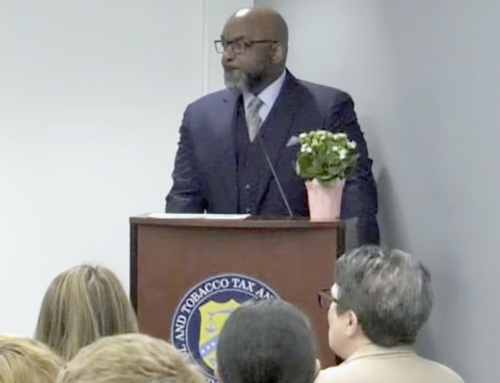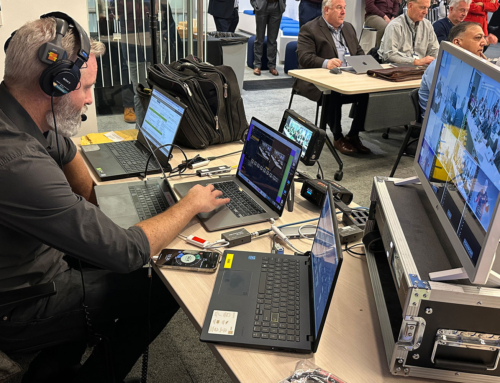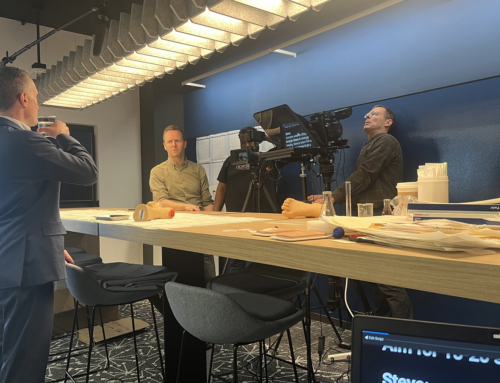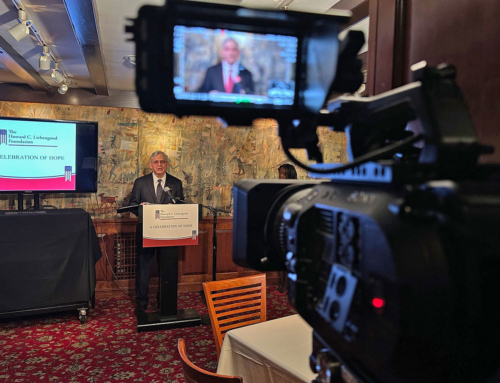A hybrid hotel event is a job at a venue that demands both in-person and remote video and audio production. Generally these jobs occur in hotel ballrooms or meeting rooms. MTI produces many such events every year. Using the example of a recent job MTI did at the Bethesda Marriott, here are the steps that we take to ensure a successful program and a happy client.
JUST LIKE IN REAL ESTATE, IT’S VENUE, VENUE, VENUE
When the client calls, confirm the date, location, time, and length of the event. Ideally, the client will have a Meeting Agenda which can be passed on to us. That way, we can begin production with a clear picture of how the client expects the day to proceed, often at a minute-to-minute level.
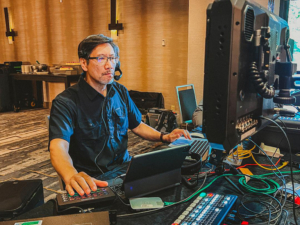
For most MTI streaming jobs, Ben Wong is the Technical Director and Streaming Director.
If you have worked for this client before, it’s important to find out if any requirements are different for the job at hand. Don’t assume that this job will be the same as a previous one. For example, in the past it was either a one-way Zoom production or featured a single guest speaker. This time, the client decided to have people ask questions remotely via Zoom.
It is a given that there will be Powerpoint presentations. Sometimes there are video roll-ins, video produced, recorded, and provided by the client or a third party. If that’s the case, you need to test them as soon as you are set up. The levels on video roll-ins can vary widely from clip to clip.
Once you know the location, you need to contact the venue and speak to the Catering Manager and/or the Audio/Visual contact. We have done several events at the Bethesda Marriott and are familiar with their team, who are top notch.
Also, you need to speak with the venue management to confirm:
- If you are setting up the afternoon before;
- If you are dropping equipment off at the venue and making sure the room is locked;
- If you are coming in early, i.e., 6 a.m., and making sure you have access to the hotel/venue.
Each place is different, and sometimes there is an entrance right to the ballroom; other times you have to load in via the loading dock.
THE RIGHT VIDEO PRODUCTION CREW IS ESSENTIAL
Next step is to hire the crew. For most MTI streaming jobs, one person will be the Technical Director/Director and Streaming Director. That person is often Ben Wong.
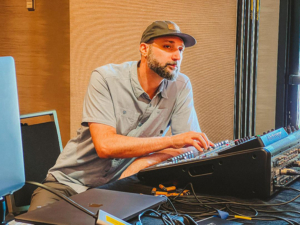
Andrew Ingaro handles the often complicated audio recording.
Audio is always challenging on these jobs because you are feeding audio in the room and to the Zoom program over the Internet, as well as taking in questions via Zoom. We have upgraded our audio board to the Behringer X32 and also have a device to ensure a clean mix-minus for Zoom participants asking questions. Andrew Ingaro is the audio engineer on this job.
Next is hiring the lead cameraman, who sets up the cameras and works with Ben Wong to arrange the lighting in the room. Ian Sbacio was our man for the latest Marriott show.
For a job like this we have a camera covering the podium and a “cuts camera” covering the audience. The cuts camera provides separate video that can be edited into the program or included live via the switching device. Depending on what other equipment is out, we will supply additional cameras at no cost (a “robo-cam” and/or a lockdown camera shooting a safe wide shot of the participants. Drew Katz served as the cuts cameraman.
THE ONLY CONSTANT IS CHANGE
Clients always change things, sometimes at the last minute. We were informed at the close of business the day before the job that they wanted to set up a podium and also a table with four chairs. This meant more microphones were needed. MTI always brings additional microphones.
It’s important to make sure that the audio specifications are agreed to by all sides. But you have to have emergency equipment. Sometimes you are bringing speakers in. Sometimes you are connecting to the house speaker system. At the Bethesda Marriott they supply a connection to the house system. Also, an Internet connection needs to be confirmed. We always prefer a hard line because with wi-fi you can get buffering.
COMMUNICATIONS ARE ESSENTIAL
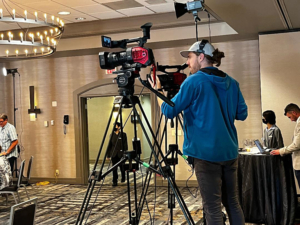
Ian Sbacio keeps everything in focus as lead cameraman.
Finally, a Production Memo is put together for the crew with a schedule and all contact phone numbers. For multi-camera shoots where we are also supplying audio we prefer to have four hours prior to the start of the event to set and test all the gear. However, that is not always possible. Basically the rule is to set up your key items first–switcher, Zoom encoder, audio board, key microphones, and camera. Then do a full test. On a Zoom event where questions are asked, Dave Lilling or someone from MTI will serve as the remote tester, which is done as soon as everything is set up.
Once everything is set up, you go over with the client contact (Tom Bello on this one) and make sure that they are happy.
Once the key elements are tested, it’s time to give the crew a break and tweak for the show.
MTI always records a double master as well as recording to at least one isolated camera. We also can transfer over the show to a hard drive once the event is over.
As always, there are no details that are too small to deal with. MTI prides itself with its attention to detail.
Metro Teleproductions, offering video production in the Washington, D.C., area for 20+ years, is owned and operated by Dave Lilling with creativity, reliability and professional excellence. Contact Dave at 301-608-9077 or dave@mtitv.com for video production success!
